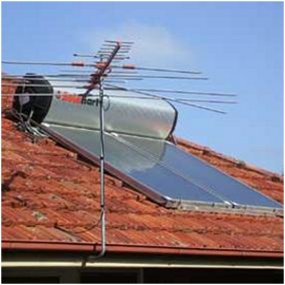Build it Back Greenbushfires
Solar Hot Water
 Installing a solar hot water system is one of the
best ways you can save money on energy bills and reduce your impact
on the environment.
Installing a solar hot water system is one of the
best ways you can save money on energy bills and reduce your impact
on the environment.
Heating water accounts for 30% of an average Australian household's energy use. However, a solar water heater can reduce your emissions by as much as four tonnes of CO2 per year-the equivalent of taking one large car off the road-simply by using the sun's energy to heat water at zero cost.
The initial purchase price will probably be higher than a similarly sized non-solar water heater but the savings in energy bills will generally pay for this difference in less than 4 to 10 years. A solar hot water system generally has a longer lifespan than a conventional unit, so financial returns can be considerable over the life of the system.
The costs for solar hot water systems range from $2000 to $8000, with a system for an average household around $4500 before rebates. State and federal government rebates are available to offset the initial costs of a solar hot water system.
Flat panel and evacuated tube collectors
Solar hot water systems use solar collectors (in the form of panels or tubes) to absorb energy from the sun. Water is heated by the sun as it passes through the collectors. It then flows into an insulated storage tank for later use. Some systems pass anti-freeze through the panels instead. This transfers heat to the water tank via a heat exchanger.
There are two types of solar collectors: Flat panel and evacuated tube. Flat panel collectors consist of a dark coloured metallic absorbing plate to which a network of pipes is bonded. This arrangement is then placed in a sealed metal box with a glass cover on the top and insulation on the back and sides to reduce heat loss. As the sun shines on the collector panel the water in the pipes becomes hot due to conduction from the collector plate.
Evacuated tube collectors consist of two glass tubes (one inside the other) that are bonded to each other at each end to form a sealed space between them (although there are single tube types too). The surface of the inner tube is coated with a heat-absorbing coating. The space between the two tubes has most of the gas removed from it (hence they are evacuated), which provides a high level of insulation, just like a thermos flask.
Evacuated tube collectors are suited to colder climates as they can perform well even on cloudy days. In cold colder climates they are a better and more efficient option than flat panel solar hot water.
Collector panels work best when placed on a north-facing roof. Also, ensure the collectors are not shaded by trees or nearby buildings, particularly in winter, when the sun is low in the sky.
Storage tanks
Hot water flows into these tanks either by a passive or active system. In passive systems, the tank is placed above the solar collectors so that cold water sinks into the collectors, where it is warmed by the sun and rises into the tank. A continuous flow of water through the collectors is created without the need for pumps.
In active systems, solar collectors are installed on the roof and the storage tank is located on the ground or another convenient location. Water is pumped through the solar collectors using a small electric pump, which is controlled by a temperature sensing controller. This option is good if you want to limit the visual impact of the system on the roof or if your roof can not support the weight of the tank.
The storage tank is usually fitted with an electric, gas or solid fuel booster that heats the water when there is not enough sunlight. At certain times of the year, such as in winter, the booster will run more than at other times. While the booster will consume energy during the cooler months the overall energy savings of a solar hot water system throughout the year will substantially offset your hot water costs. To help save energy locate your solar hot water system as close to wet areas as possible to reduce heat losses in the pipes. Also insulate the piping to helpfurther reduce heat losses.
Suppliers
Endless Solar - www.endless-solar.com
Ph. 1300 889 585
Aquamax - www.aquamax.com.au
Ph. 1800 676 000
Dux - www.dux.com.au
Ph. 1300 365 116
Ecosmart - www.ecosmart.com.au
Ph. 133 326
Edwards Solar Hot Water - www.edwards.com.au
Ph. 1300 765 277
Hills Solar - www.hillssolar.com.au
Ph. 1300 363 386
Sola-Kleen - www.sola-kleen.com.au
Ph. 08 9271 5725
Apricus Australia - www.apricus.com.au
Ph. 1300 277 428
Conergy - www.conergy.com.au
Ph. 1300 551 303
Rheem - www.rheem.com.au
Ph. 132 552
Listed suppliers are a guide and are not endorsed by Green Cross Australia or the Alternative Technology Association.


